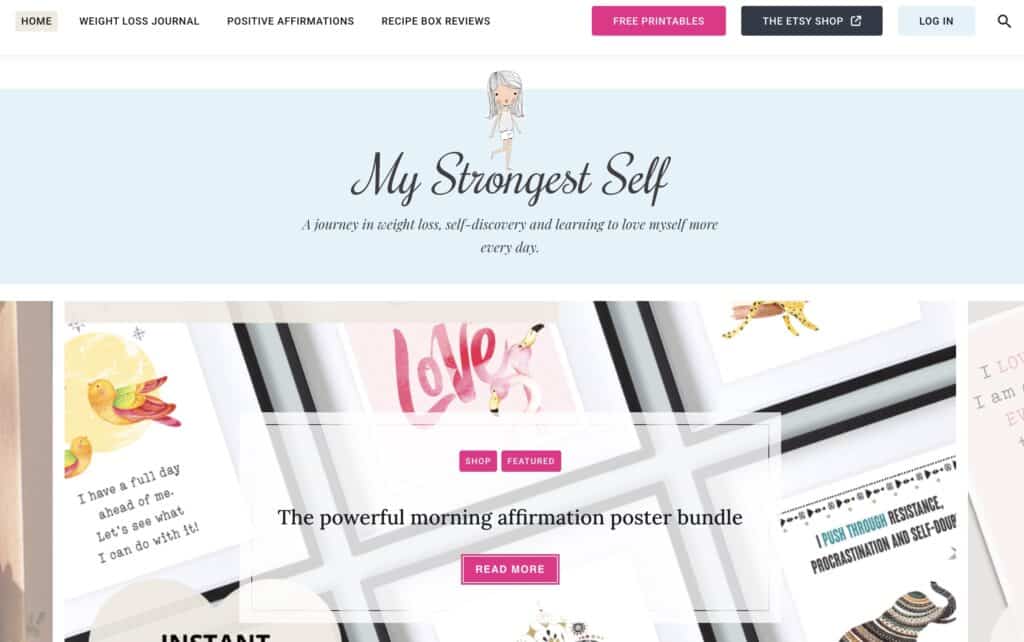If you’ve been on a successful weight loss journey, then you might be motivated to help other people adopt a healthy lifestyle and reach their own weight loss goals. One effective way to do that is through blogging, a versatile medium that allows you to share your healthy eating, wellness, and fitness tips with the world, while potentially making money in the process.
It’s important to keep in mind that there’s no shortage of dietary blogs already out there for web users to read. As such, a blogger hoping to build an audience of loyal visitors will need to do everything they can to stand out from the crowd and make their voice heard.
This can be challenging, but it’s certainly not impossible! Beginner bloggers who are starting their own weight loss blog should have confidence that they possess something valuable to offer the world. In this post, we will discuss the value of creating your own blog and provide ten useful tips to help you get off to the best possible start.
Why start a weight loss blog?
If you’ve successfully achieved your own weight loss goals, you have something valuable to offer the world. Weight management is a prevalent issue in society, and sharing your personal journey through a weight loss blog allows you to document your experiences, connect with others on a similar path, and provide genuine motivation and accountability.
The importance people place on weight loss makes it possible to build a loyal audience who seeks your guidance and support. 51% of people in the United States are on their own weight loss journey, and this number is even higher in some other countries, like Chile and Peru. By offering valuable content, you can inspire others to become the best version of themselves while potentially earning income through various monetization methods.
However, entering the crowded weight loss blogging sector comes with challenges. Finding a unique niche, choosing the right domain name, and setting up a reliable web hosting service can be daunting. In this guide, we will address these pain points and provide valuable advice to help you overcome these challenges.
10 Steps to start your weight loss blog
1. Choose your niche
It’s always best to be as specific as possible when you’re trying to break into a crowded market, which the weight loss market certainly is. A niche allows you to focus your content and expertise on a particular area, making it easier to connect with individuals who are specifically interested in that topic.
Some examples of weight loss niches include intermittent fasting, vegan weight loss, weight loss for postpartum mothers, senior fitness and weight loss, gluten-free weight loss, paleo or keto diet weight loss, weight loss for diabetics, and weight loss through mindful eating.
Looking for some inspiration? Check out the below health blogs, all of which have found success within a specific niche.
- The Lean Green Bean: An education-focused blog run by a registered dietician that avoids ‘fad dieting.’
- Snack Girl: This blog focuses on healthy alternatives to popular and indulgent snacks.
- My Strongest Self: A blog focused on combining weight loss with mental health and mindfulness.
- So Very Blessed: A blog that combines faith and weight loss.

When choosing your niche, be sure to select one that aligns with your experiences and interests. You can’t write sincerely if you have no natural connection to the topic, so take a closer look at your weight loss journey, and try to identify what sets it apart from other experiences.
2. Choose a blogging platform
When it comes to choosing a Content Management System (CMS), then it’s hard to look past the world’s leading blogging platform, WordPress. Its user-friendly interface, extensive customization options, and vast plugin library make it an ideal platform for creating and managing a successful weight loss blog.
WordPress offers a straightforward and intuitive CMS, allowing bloggers to easily create and publish posts without requiring advanced technical knowledge. Additionally, its wide range of themes and design options enables bloggers to customize their websites to reflect their unique branding and style.
One of the key advantages of WordPress is its extensive plugin library. With thousands of plugins available, weight loss bloggers can enhance their sites with features like social media integration, SEO optimization, and community forums, enhancing the overall user experience. One essential plugin for weight loss bloggers that we’ll look at later is WP Recipe Maker, which helps you add stunning recipe cards to your blog posts.
While platforms like Blogger and Wix are also popular options, they don’t quite match the versatility and flexibility of WordPress. Blogger is relatively simpler and may lack some advanced features, while Wix offers ease of use but limits customization options.
3. Select a domain name and hosting provider
When selecting a domain name for your weight loss blog, it’s important to choose a unique and memorable name that reflects your blog’s niche and target audience. Consider incorporating keywords related to weight loss or your specific niche to make it more search engine-friendly.
For example, if your website is focused on healthy recipes designed to give you lots of energy for workouts, you might want to call it www.FitandFueled.com. Aim for a name that is easy to spell, pronounce, and remember, as it will contribute to your brand identity.
You’ll also need to select a web hosting provider if you’re going down the WordPress route. Keep in mind that not all hosting providers are created equal. It’s best to choose one that’s reliable, offers good customer support, and provides solid uptime. Bluehost and SiteGround are two of the most popular and cost-effective options for individual WordPress users (i.e., not companies).
4. Set up essential pages
Every weight loss blog should have essential pages to provide a comprehensive user experience. These include:
- Blog page: This is the core of your weight loss blog, featuring categorized posts to share valuable content, tips, and insights. Ensure it is well-organized and easy to navigate.
- Recipe pages: Include dedicated pages to showcase healthy and delicious recipes relevant to your weight loss niche. Provide clear instructions, nutritional information, and visually appealing images.
- Success stories and testimonials: Share inspiring success stories or testimonials from individuals who have achieved weight loss goals through your guidance. This builds trust and motivates your audience.
- Shop page (if selling products): If you sell weight loss-related products, create a shop page with detailed product descriptions, high-quality images, and an easy purchasing process.
- Events/workshop page (if applicable): If you organize events or workshops related to weight loss, create a page to promote and provide details about upcoming events, including dates, locations, and registration information.
- About page: Introduce yourself, share your weight loss journey, qualifications, and your mission for the blog. This page helps establish a personal connection with your audience.
- Contact page: Provide a dedicated contact page for visitors to reach out to you for inquiries, collaborations, or feedback. Include a contact form or direct contact information.
- Privacy policy and terms and conditions: These pages are important to ensure transparency, legal compliance, and protect user privacy. Include clear explanations of how user data is handled and the terms of use for your website.
5. Get your branding right
Consistent branding plays a vital role in making your website memorable and distinguishing it from competitors. Although branding may initially seem confusing, you don’t need to be an expert to apply branding concepts to your weight loss blog. By maintaining a consistent color scheme, typography, and having your own logo, you can effectively establish the visual aspect of your brand.
Using WordPress, it’s easy to handle the color scheme and typography by yourself, either by using the settings available in your WordPress theme or by using a page builder like Elementor.
On the other hand, logo design often poses a challenge. Fortunately, there are logo creation tools available for crafting your own logo, like LOGO.com, or you can hire a designer to create one that aligns with the theme and content of your blog.
Branding is not solely about aesthetics; it also encompasses your personal presence. When considering your branding, consider how you present yourself. What do you want visitors to know about you? Why did you start your blog? Sharing details such as favorite recipes, lifestyle choices, personal anecdotes, and, most importantly, your health journey, is crucial for establishing a genuine connection with your audience through personal branding.
Successful weight loss blogs often incorporate personal stories that enhance their brand. Take a look at the ‘about’ pages of “Runs for Cookies” and “A Black Girl’s Guide to Weight Loss” for two compelling examples.
6. Start creating content
The quality of your content will be the most influential factor behind the overall success or failure of your weight loss blog. Even the greatest branding in the world can’t make up for low-quality content that doesn’t offer value to the reader.
So what constitutes value for the reader? It’s all about providing solutions to the problems they’re dealing with, and providing them with the motivation they need to take action towards achieving their weight loss goals. To generate content ideas, conduct keyword research, stay updated on industry trends, and draw from personal experiences.
Here are a few ideas to get the wheels – or running shoes – in motion:
- Your personal weight loss journey
- Provide meal plans and recipes
- Effective weight loss exercise routines and plans
- Interviews with a dietician, healthcare professional, or personal trainer
- Tips and tricks for healthy eating
- Reviewing fitness products and diet programs
To maximize audience engagement, it’s best to offer a variety of content types. After all, people prefer to consume content in different ways! Blog posts, videos, infographics, and podcasts are just some of the mediums you can use to communicate your messages.
Be sure to add disclaimers on your weight loss and health-related advice and information, indicating that your content should be taken as guidance only, and should not be considered professional advice – unless you truly are a professional.
7. Showcase your recipes
Weight loss blogs tend to be a mixture of fitness/lifestyle content and healthy recipes. To increase engagement, it’s important to showcase your recipes in a visually appealing, organized way, that’s in line with your overall brand.
WP Recipe Maker is a WordPress plugin that allows you to do just that and includes essential features for all food bloggers who want to display recipes on their blog posts. These include:
- Customizable recipe templates and easy-to-use template editors which allow blog owners to present their recipes in visual alignment with the website’s overall branding.
- Nutrition API integration for providing nutritional values of recipes, an important feature for weight-loss-focused audiences.
- Adjustable servings and shopping list creation features provide a user-friendly experience.
- Automatic recipe metadata generation for search engine optimization.
- The unit conversion feature which makes recipes accessible to international audiences.
- The ability to place affiliate links within your ingredients for easy monetization.
This plugin is essential for enhancing engagement on your weight loss blog. WP Recipe Maker is the most popular recipe plugin within the WordPress repository, and that’s all due to its extensive features and high-quality functionality.

8. Promote your weight loss blog
Producing great, valuable content and presenting it in a visually-appealing manner is essential, but your website won’t be successful if no one knows it exists.
Once you’ve published content on your blog, it’ll be time to get down to the busy work of marketing. There are plenty of effective ways to promote your blog, including social media marketing, email marketing, guest posting, and collaborating with other bloggers within your niche.
In practice, you’ll probably use a mixture of all these strategies. It’s also essential to ensure that Google (and other search engines) can find your website. Keyword research is important, so you should look into specific weight loss and health-related keywords that people are looking up so that you can build high-quality content around these queries.
WP Recipe Maker also helps with SEO as it handles your recipe metadata, increasing the chances that your recipes will appear in search results as rich snippets.
Keep in mind that you’re not aiming to attract a bunch of one-time visitors. You’re trying to attract repeat visitors. Only then can you build a community that’s based on loyalty and trust. An important step in achieving this goal is to actively engage with your readers. Responding to comments, posting surveys/polls, and hosting giveaways are all effective methods for developing mutual trust and loyalty.
9. Monetize your blog and build affiliate connections
The weight loss market is big business – the market is projected to reach a valuation of $292.2 billion by 2024. In other words, there’s a lot of potential for weight loss blog owners to tap into this lucrative market and generate an income.
There’s more than one way to monetize your weight loss blog. Some of the most popular methods include affiliate marketing, sponsored content, website advertisements, product reviews, and selling products and services.
Brand partnerships can also be an effective source of income. Some common entities that weight loss blogs partner with include nutritional supplement brands, fitness tech products (such as FitBit), mental health apps and services, and personal trainers.
Building connections will be at the heart of your ability to generate income. Joining relevant affiliate programs, promoting products relevant to your blog’s niche/target audience, and establishing partnerships with other websites will all help.
WP Recipe Maker can help with your blog monetization in a few different ways, for example:
- Placing affiliate ingredient and equipment links within your content, which you can manage in one place.
- Integrations with grocery providers that can earn a commission for orders.
- Its SEO features which help attract more visitors, thereby improving ad impressions and click rates.
10. Be realistic, stay positive, and adapt to Changes
It takes time to build a weight loss blog that attracts readers and generates income. It won’t happen overnight. But if you stay realistic, work hard, and have patience, then you’ll be in a strong position to generate an income. Avocadu, a weight loss blog, reported to have made $140,000 in a single month, though this was the result of years of hard work.
You can stay on the right path by maintaining a positive attitude. If you set achievable goals, celebrate your small victories, and stay open to new ideas and strategies, then you never know what your blog could lead to. Ultimately, the ones that reach the top are the ones that show consistent effort.
Launch your weight loss blog today!
Competition for weight loss blog readers can be intense, but with valuable content, you can find your audience. To increase your chances of success, follow the tips mentioned in this post – by implementing this step-by-step guide, your blog will be well-positioned for success.
If you plan on publishing healthy and nutritious recipes on your WordPress food blog, make use of WP Recipe Maker to enhance your blog’s recipe presentation. The plugin allows weight loss bloggers to publish visually appealing and well-organized recipe cards that are optimized for search engines.
Your weight loss journey was a success; now it’s time to excel at your blogging journey. Get started with WP Recipe Maker today!






